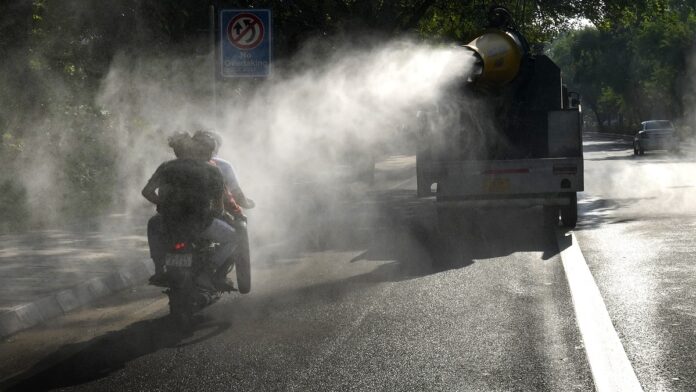
Delhi’s air was ‘very poor’ on the morning after Diwali but relatively better than in previous years
The air quality in Delhi on the morning after Diwali was recorded in the ‘very poor’ category but the situation was relatively better than previous years due to favourable meteorological conditions which diluted the effect of firecrackers and stubble burning.
According to forecasting agencies, the city is set to record its best air quality for the day after Diwali since 2015 on Tuesday.
On Monday night, people in Delhi flouted the ban on firecrackers with impunity. PM2.5 concentration at most places in the capital was over 550 micrograms per cubic metre by 1 am. However, PM2.5 levels dropped below 350 micrograms per cubic metre by 10 am due to warm and windier conditions.

PM2.5 are fine particles that are 2.5 microns or less in diameter and can travel deep into the respiratory tract, reaching the lungs and entering the bloodstream.
The capital’s air quality index (AQI) stood at 310 at 11 pm on Monday. It increased to 326 by 6 am on Tuesday, remained stable till 9 am and started decreasing thereafter.
The neighbouring cities of Ghaziabad (272), Noida (312), Greater Noida (282), Gurugram (313) and Faridabad (311) reported ‘poor’ to ‘very poor’ air quality at 9 am.
An AQI between zero and 50 is considered ‘good’, 51 and 100 ‘satisfactory’, 101 and 200 ‘moderate’, 201 and 300 ‘poor’, 301 and 400 ‘very poor’, and 401 and 500 ‘severe’.
“Bursting of firecrackers led to a sharp increase in air pollution with PM2.5 concentration, on an average, jumping to 550 micrograms per cubic metre across Delhi by 1 am,” Sunil Dahiya, an analyst at the Centre for Research on Energy and Clean Air (CREA), told PTI.

The Delhi government had in September announced a complete ban on the production, sale and use of all types of firecrackers till January 1, 2023, including on Diwali, a practice it has been following for the last two years.
Farm fires raged across Punjab and Haryana on Monday but the wind direction changed to south westerly, which is unfavourable for the transport of smoke. Hence, the contribution of stubble burning to Delhi’s pollution (five to eight per cent) was also “not very significant”, said Gufran Beig, chair professor, National Institute of Advanced Studies, Indian Institute of Science.
Emissions from firecrackers and farm fires have contributed significantly to Delhi’s PM2.5 pollution on Diwali over the years.
The share of farm fires in Delhi’s PM2.5 pollution was 25 per cent on Diwali in 2021, 32 per cent in 2020 and 19 per cent in 2019.

Since Diwali was observed early in the season this year, moderately warm and windier conditions prevented rapid accumulation of pollutants from firecrackers bursting and reduced the effect of stubble burning.
Diwali was celebrated on November 4 in 2021 and on November 14 in 2020 when temperatures were considerably low and winds calm.
Dahiya said stubble burning in Punjab and Haryana peaks only in October-end and November and hence its contribution to air pollution on Diwali was not very significant. However, it is likely to rise sharply in the upcoming days.
According to the Early Warning System of the Indian Institute of Tropical Meteorology (IITM), the air quality is predicted to remain in the ‘very poor’ category during the day (Tuesday) and is likely to improve slightly over the next two days.
Delhi recorded a 24-hour average AQI of 312 at 4 pm on Monday — the second best for Diwali day in seven years.
Before this, the city recorded an AQI of 281 on Diwali in 2018.
)
Delhi had recorded an AQI of 382 on Diwali last year, 414 in 2020, 337 in 2019, 319 in 2017, and 431 in 2016, according to Central Pollution Control Board data.
On Sunday evening, the city reported a 24-hour average AQI of 259, which was the lowest for Diwali eve in seven years.
The Indian Agricultural Research Institute reported 1,019 farm fires in Punjab, 250 in Haryana and 215 in Uttar Pradesh on Monday evening.
The System of Air Quality and Weather Forecasting and Research (SAFAR) had earlier predicted that the air quality in Delhi would be recorded in the ‘very poor’ category if no firecrackers are burst.

In case firecrackers are burst like last year, the air quality may plunge to ‘severe’ levels on the night of Diwali itself, it had said.
Delhi Environment Minister Gopal Rai had earlier said bursting of firecrackers on Diwali in the city will attract a jail term of up to six months and a fine of Rs 200.
He had said production, storage and sale of firecrackers here will be punishable with a fine of up to Rs 5,000 and three years in jail under Section 9B of the Explosives Act.
A total of 408 teams have been constituted to implement the ban. The Delhi Police has set up 210 teams under assistant commissioners of police, the Department of Revenue has set up 165 teams and the Delhi Pollution Control Committee has constituted 33 teams.
